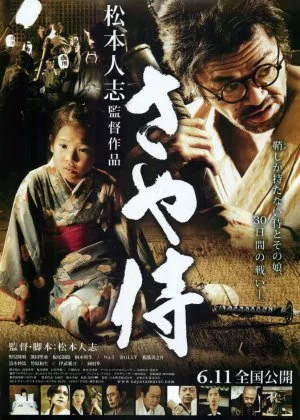Saya-zamurai

Hitoshi Matsumoto (Symbol, Dai-Nipponjin) is back! The man made only two films prior to Saya-Zamurai, but he gained instant access to my list of favorite Japanese directors thanks to his excessively dry humor and quirky direction. Matsumoto remained behind the camera for his latest film and toned down the weirdness level a little, but if you are comfortable with his sense of humor there's still heaps and heaps to enjoy here.

There's little to none of the weirdness you might have come to expect from Matsumoto's previous films, so people looking for a direct continuation of his earlier work might be somewhat disappointed with this film. Saya-Zamurai draws comparisons to the funnier moments in Kitano's Zatoichi though, while Matsumoto's deadpan humor clearly sets itself apart from Kitano's more juicy approach to comedy.
The film starts off in traditional samurai fashion. A lonely man approaches a bridge, a figure looms on the other side. Slowly they walk towards each other, only to attack once they've passed each other right in the middle of the bridge. But then something weird happens. The samurai who's struck down runs off bleeding and screaming. This is clearly not going to be a typical samurai film after all. The samurai's daughter follows him from a small distance, not hiding the disdain and disappointment she feels about her father's behavior.
Kanjuro is a runaway samurai, after his wife died of the flue so did his vigor and spirit to live. When he is captured for forsaking his duties as a samurai, Kanuro is sentenced to perform a rather peculiar task. He has 30 days to make a young kid laugh, if not he has to perform seppuku. This is easier said than done as the boy seems completely cut off from the world, the fact that Kanjuro isn't feeling too good about himself isn't really helping either. Lucky for him he gets some pointers from his daughter and the two men that guard him.

Since the story of Saya-Zamurai is more down to earth there isn't as much room for crazy CG and random visual weirdness. Matsumoto is an inventive guy though and the beginning has some rather modern visual twists. The remainder of the film is more traditional but stylish and warm. Strong shots and beautiful camera work all over. And there are of course the awesome wooden structures that appear later in the film, also adding a lot to the visual richness of Saya-Zamurai.
The score is pretty traditional, though it does feature some very nice, light and warm touches that lift it above the more generic soundtracks out there. At times it even feels as if Joe Hisaishi had his hand in some of the music, but the credits seem to contradict this. It's a pretty interesting detail though, all the more when you know that Matsumoto and Kitano are two of the most popular comedians in Japan and some kind of rivalry definitely exists between the both of them.
The acting in Saya-Zamurai is top notch. Secondary roles are strong, especially the supporting role of Kanjuro's daughter, but in the end it's Takaaki Nomi in his first ever movie role that impresses the most. He has almost no lines and features only one or two facial expressions, but he does it with so much passion and dedication that his character really grows on you. On top of that, he has the perfect face for taking Matsumoto's deadpan humor to the next level. A remarkable man, though he might suffer the consequences when he tries on a different character, as Takaaki Nomi really becomes Kanjuro in this film.

After a short intro the film quickly settles itself in a very cyclic structure. Kanjuro has 30 days to make the boy smile, so we get 30 sequences of him doing just that. Sometimes there is a short break where the guards and the daughter are coming up with new ideas, but most of the time we see Kanjuro performing a series of very silly tricks and dances. As the film progresses, Kanjuro's performances do become more elaborate and spectacular, but the basics remain the same. Though none of the jokes are very funny by themselves, when put in this dead serious context they manage to become pretty hilarious.
The ending takes a more serious and dramatic twist, though the film as a whole does not lose its light-hearted atmosphere. It's a very fitting and beautiful finale though, one that brings a bit of laughter and comedy to an otherwise sad ending. Not as spectacular as the ending of Symbol, or as zany as the finale of Dai-Nipponjin, but more in line with the rest of Saya-Zamurai.
Matsumoto's new film is a little gem, a film that does not impress in spades but focuses on smaller details. One thing remained though, Matsumoto's deadpan humor is still the star of the film, this time embodied by Takaaki Nomi. The film may be overshadowed by Matsumoto's earlier efforts, but as a stand-alone work it's a highly amusing, entertaining and endearing film that deserves a bit more praise than it has been getting so far.